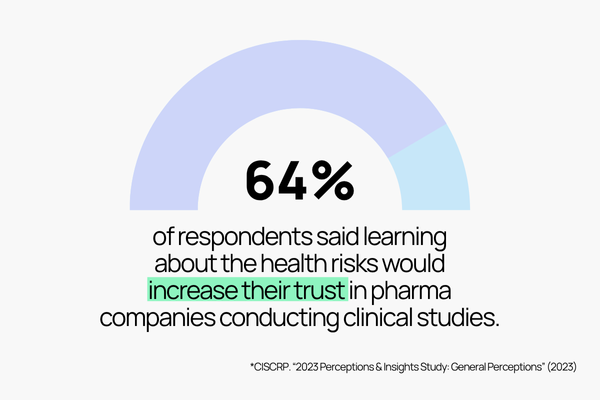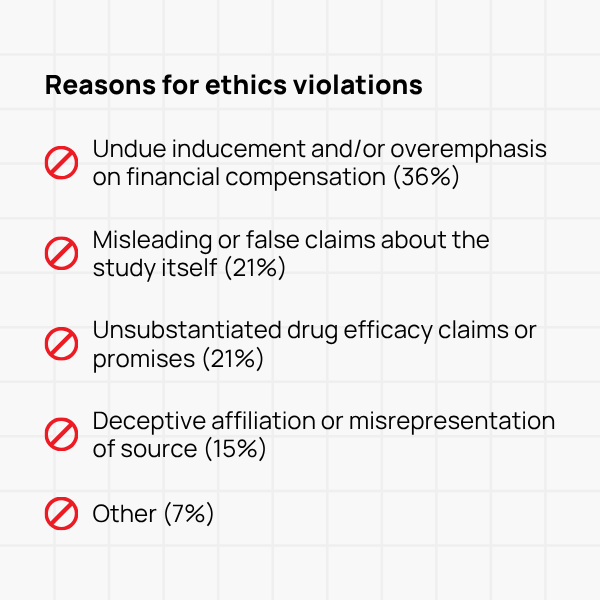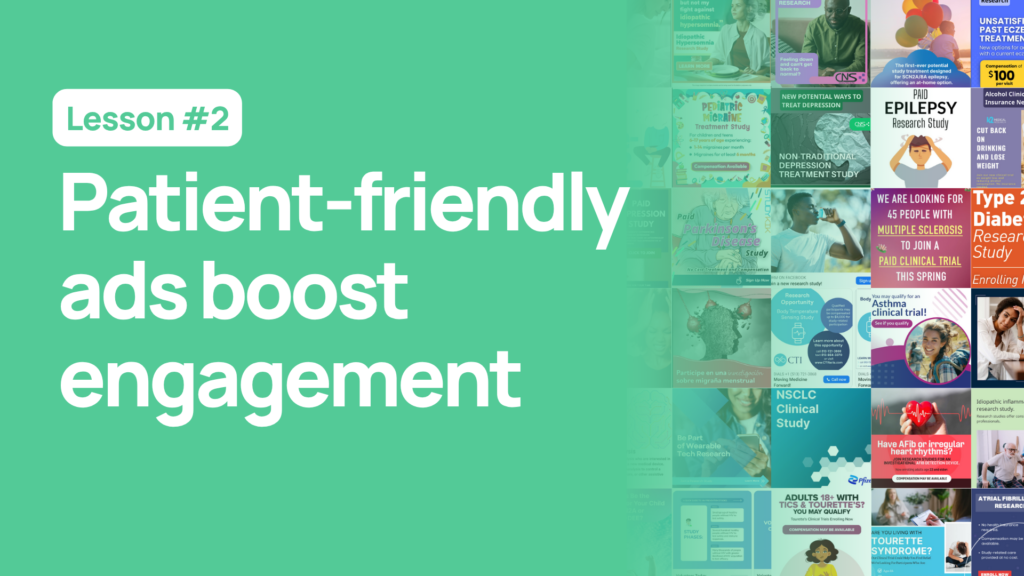Ethics and openness win patient trust.
This is just one lesson we learned!
Download the full eBook to explore all the insights we gained from analyzing 100 live patient recruitment ads.
The hidden challenge of patient recruitment
Recruiting patients for clinical trials is a challenge that often goes unseen. Delays can feel inevitable, budgets expand, and promising research sometimes fades, not because the science failed, but because no one knew it was happening.
Patients, meanwhile, are bombarded daily with digital messages. If an ad feels even slightly off, too generic, too clinical, or too detached they’ll scroll right past. Digital advertising offers new hope, allowing us to reach more of the right people, but only if the message feels human and authentic.

Honesty as the foundation of trust
Recruiting patients for clinical trials is a challenge that often goes unseen. Delays can feel inevitable, budgets expand, and promising research sometimes fades, not because the science failed, but because no one knew it was happening.
Patients, meanwhile, are bombarded daily with digital messages. If an ad feels even slightly off, too generic, too clinical, or too detached they’ll scroll right past. Digital advertising offers new hope, allowing us to reach more of the right people, but only if the message feels human and authentic.

The strategic importance of being honest in patient recruitment
In patient recruitment, every word carries weight. Clinical trial ads are the first point of contact between researchers and people making deeply personal health decisions. When an ad overpromises or glosses over key details, it doesn’t inspire confidence; it raises alarms. Messages like “No side effects!” or “$2,000 for nothing!” aren’t hooks, they’re red flags. Patients are quick to sense when something feels too good to be true, and instead of engaging, they walk away.

Honesty gives people the respect of real information. According to CISCRP’s 2023 findings, 64% of respondents said learning about the health risks would actually increase their trust in pharmaceutical companies running clinical studies.
People don’t expect perfection; they expect candor. When recruitment messages clearly acknowledge potential side effects or uncertainties, they show that the study values participants’ right to make informed decisions. In a landscape crowded with ads competing for attention, truth stands out.
Common themes in patient recruitment visuals
Of all 100 patient recruitment ads we studied, 14% crossed this line, losing an opportunity to engage meaningfully, and in some cases, creating blowback in the form of negative comments.

Why this matters for patient recruitment
In our analysis, more than one in three recruitment ads (36%) showed undue inducement—placing outsized emphasis on financial compensation or portraying participation as “easy money.” Another 21% made misleading or false claims about the study itself, and an additional 21% went further by offering unsubstantiated promises about drug efficacy. Finally, 15% misrepresented their source or affiliation, creating a deceptive sense of credibility. Each of these missteps may seem small in isolation, but together, they signal a troubling pattern: when recruitment messaging prioritizes clicks over clarity, it crosses ethical lines that put both patient safety and organizational reputation at risk.
These findings aren’t just a compliance concern, they’re a strategic one. Ethical lapses in recruitment communication can erode years of brand trust, damage partnerships, and invite regulatory scrutiny. But the inverse is also true: when organizations lead with transparency, they not only protect themselves but strengthen the bridge between science and the public.
How this looks with real-world patient recruitment ads

Inducement and/or misrepresentation of financial compensation: The graphic headline, first line of graphic text, and caption all mention financial compensation. If you include the second line of graphic text saying the medication is available at “no cost,” then every sentence on this ad mentions compensation.
Misleading false claims about the study itself: The headline “Free Care & $2,000” does not qualify either of those claims enough for patients to understand that it is for patients who are medically eligible and who participate in the entire study. The $2,000 is also likely paid out in increments of $50-$100 over many visits.

Unsubstantiated drug efficacy claims: The headline says “Unlock a healthier future for your child” implying that the study drug is effective and those who don’t click are not interested in a healthier future for their child. Neither of those are substantiated in the recruitment ad.
Misrepresentation of source: The name of the group sharing this (“Parkinson’s Disease Awareness”) makes it look like this is being shared by a support group or an advocacy organization, but it’s not. This recruitment ad was created by a patient recruitment vendor on behalf of a sponsor.





